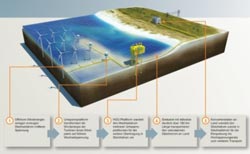Enhanced Power Transmission for HVDC

<br>
This minimizes losses during power transmission and is one of the key technologies required to make better use of renewable sources of energy for the power grid.
A research project launched by Germany's Federal Ministry of Education and Research (BMBF) aims to improve power conversion both at the beginning and the end of the HVDCT line.
Using the technologies under research, the cost of these converter stations could be cut by as much as 20 percent and power density increased by a third. Further synergies will be created when these new technologies are used in conjunction with power generated from wind turbines.
The Siemens global research unit Corporate Technology is coordinating the project. Scheduled to run for three years, “Efficient High-Performance Modules for the Electrical Energy System of the Future” (EHLMOZ) is being funded by the BMBF to the tune of €4.9 million. The remaining project partners are TU Dresden, Infineon Technologies, Curamik Electronics, Nanotest, and Fraunhofer ENAS.
In order to minimize transmission losses, HVDC converter stations convert alternating current into direct current at a very high voltage and then back again. Germany is now planning to construct 2,100 kilometers of HVDCT lines in order to transmit with minimal loss wind power from its coastline to consumers inland. Germany also intends to build further offshore wind turbines with a combined output of 25 gigawatts, scheduled for completion by 2030. This power, too, will be transmitted to the coast via HVDCT.
The latest development in the field of HVDC power conversion is modular multilevel converters. An array of insulated-gate bipolar transistors (IGBTs) and capacitors connected in series incrementally create the desired voltage. The IGBTs are exposed to high and fluctuating currents in the converters over a period of several decades.
These high currents generate considerable heat at the electrical contacts of the components. Fluctuations in current and, as a result, in temperature can cause the wire bonding to lift or solder joints to crack. In turn, short circuits lead to high peak currents that can damage the component and even neighboring modules. To guard against this risk, current systems feature additional power electronics and twin-cell housing.
Areas of research in the EHLMOZ project include new power semiconductor devices that are robust enough to enable a significant reduction in the level of protection currently required. Researchers hope that that an enhanced layout and better connection techniques with large contact surfaces will improve distribution of the thermal load. Other areas of research include measuring techniques for precisely monitoring the temperature in the module and thereby enabling a reduction in the safety margins required.
Media Contact
More Information:
http://www.siemens.com/innovationnewsAll latest news from the category: Power and Electrical Engineering
This topic covers issues related to energy generation, conversion, transportation and consumption and how the industry is addressing the challenge of energy efficiency in general.
innovations-report provides in-depth and informative reports and articles on subjects ranging from wind energy, fuel cell technology, solar energy, geothermal energy, petroleum, gas, nuclear engineering, alternative energy and energy efficiency to fusion, hydrogen and superconductor technologies.
Newest articles

Bringing bio-inspired robots to life
Nebraska researcher Eric Markvicka gets NSF CAREER Award to pursue manufacture of novel materials for soft robotics and stretchable electronics. Engineers are increasingly eager to develop robots that mimic the…

Bella moths use poison to attract mates
Scientists are closer to finding out how. Pyrrolizidine alkaloids are as bitter and toxic as they are hard to pronounce. They’re produced by several different types of plants and are…

AI tool creates ‘synthetic’ images of cells
…for enhanced microscopy analysis. Observing individual cells through microscopes can reveal a range of important cell biological phenomena that frequently play a role in human diseases, but the process of…





















